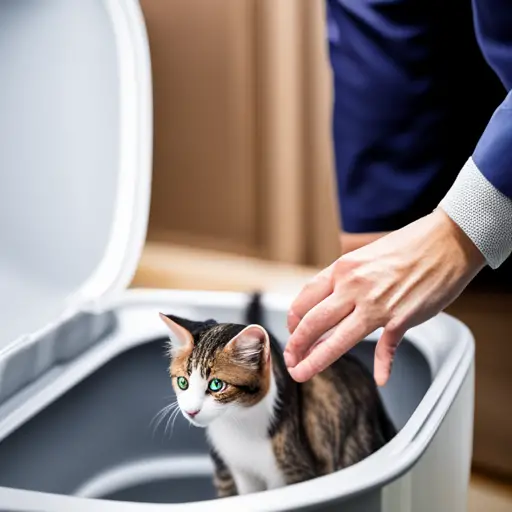If you’re the proud owner of an adult cat that hasn’t quite mastered the art of using the litter box, you’re not alone. Litter box training can be frustrating, but with the right tips and tricks, you can help your feline friend learn to use the box consistently. This will make your life easier and improve your cat’s quality of life by providing them with a clean and comfortable space to do their business.
In this article, we’ll guide you through litter box training adult cats, from choosing the right litter box and litter to troubleshooting common problems. Whether you’re dealing with a cat that’s never used a litter box or has developed bad habits, we’ve got you covered.
With a little patience and some expert advice, you’ll be well on your way to a happy and healthy relationship with your feline companion. So, let’s get started!
Key Takeaways
- Choose the right litter box size and location for your cat’s comfort and privacy.
- Introduce your cat to the litter box gradually with rewards for using it.
- Troubleshoot litter box problems by experimenting with different types of litter and consulting a veterinarian if necessary.
- Maintain a clean litter box with regular scooping and odor control to ensure your cat’s health and happiness.
Additionally, consider using eco-friendly litter options which are better for the environment and safer for your cat.
Choose the Right Litter Box

You’ll want to ensure you’ve picked the right litter box for your adult cat. The size of the box matters, as you’ll want to choose one that is large enough for your cat to move around comfortably. If the box is too small, your cat may feel cramped and avoid using it altogether.
Location considerations are also important. You want to place the litter box in a quiet, private area where your cat can do their business without feeling watched or disturbed. Avoid placing it in high-traffic areas or near noisy appliances, as this may cause your cat to feel stressed and reluctant to use the litter box.
By selecting the right litter box and location, you can make the litter box training process much smoother and easier for you and your feline friend.
Choose the Right Type of Litter

Selecting the appropriate material for your feline’s bathroom is essential in their successful transition to indoor living. When choosing the right type of litter for your adult cat, there are several factors to consider.
One of the most important factors is the litter box odor. You want to choose a litter that will mask the odor of your cat’s waste, keeping your home smelling fresh. Look for activated carbon or baking soda litter, as these effectively neutralize odors.
Another important factor to consider is eco-friendliness. Many traditional litters are made from clay, which is not biodegradable and can harm the environment. Consider eco-friendly options like recycled paper, wood chips, or plant-based materials. These types of litter are better for the environment and can also be safer for your cat, as they are less likely to inhale dust particles from traditional clay litter.
Considering the odor and eco-friendliness of your cat’s litter, you can ensure a comfortable and safe environment for you and your furry friend.
Introduce Your Cat to the Litter Box

Before bringing home your new feline friend, showing them where they can do their business is crucial. Introducing your cat to the litter box can be a gradual training process that requires patience, understanding of cat behavior, and rewards.
To start, place the litter box in a quiet and accessible location where your cat can easily find it. Allow your cat to explore the litter box independently and avoid forcing them to use it.
If your cat seems hesitant or scared, try placing them in the litter box and gently scratching the litter with their paw. This will help them understand that the litter box is where they should go to do their business.
Remember to reward your cat each time they use the litter box, whether with a treat or verbal praise. With time and patience, your cat will become litter box trained, and your home will be a cleaner and happier environment for you and your feline friend.
Troubleshoot Litter Box Problems

Dealing with litter box issues can be frustrating, but there are solutions to help resolve the problem. If your cat isn’t using the litter box, it could be due to behavioral issues. For example, your cat may not like the type of litter you’re using or may be stressed due to environmental changes.
Here are some tips to help you troubleshoot litter box problems:
- Experiment with different litter types to find one your cat prefers.
- Clean the litter box regularly to ensure it’s always clean and fresh.
- Place the litter box in a quiet, private area where your cat feels safe and secure.
If the problem persists, consult a veterinarian who can rule out any underlying health issues and provide additional guidance on addressing behavioral issues.
Addressing litter box problems can help ensure your cat is happy and healthy. You can find a solution that works for you and your feline friend with patience and persistence. If necessary, consult a veterinarian, as they can provide valuable insights and guidance on resolving litter box issues.
Maintain the Litter Box

Keeping your cat’s litter box clean and well-maintained is crucial for their health and happiness. Scooping frequency is one of the most important aspects of maintaining a litter box. You must scoop your cat’s litter box at least once or twice a day if you have more than one cat. This will prevent the litter box from becoming too dirty and smelly, which can discourage your cat from using it.
Another important aspect of maintaining a litter box is odor control. Many products, such as deodorizers and special litter, are available to help control the odor of your cat’s waste. However, keeping the litter box clean is the best way to control the odor. If you notice a strong odor from the litter box, it’s time to scoop it.
Additionally, you should completely replace the litter and clean the box every two to four weeks, depending on how many cats you have and how often they use it. By keeping your cat’s litter box clean and well-maintained, you are ensuring their comfort and happiness.
Conclusion
Congratulations! You’ve successfully litter box trained your adult cat! It may have taken some time and effort, but having a happy and tidy household was worth it.
Remember to continue maintaining the litter box by scooping it daily and replacing the litter at least once a week.
If your cat starts exhibiting litter box problems again, don’t panic. Take a step back and identify any changes in their environment or routine that may have caused the issue.
You can get your cat back on track with their litter box habits with patience and persistence. Keep up the good work, and enjoy a cleaner and happier home with your feline friend!

